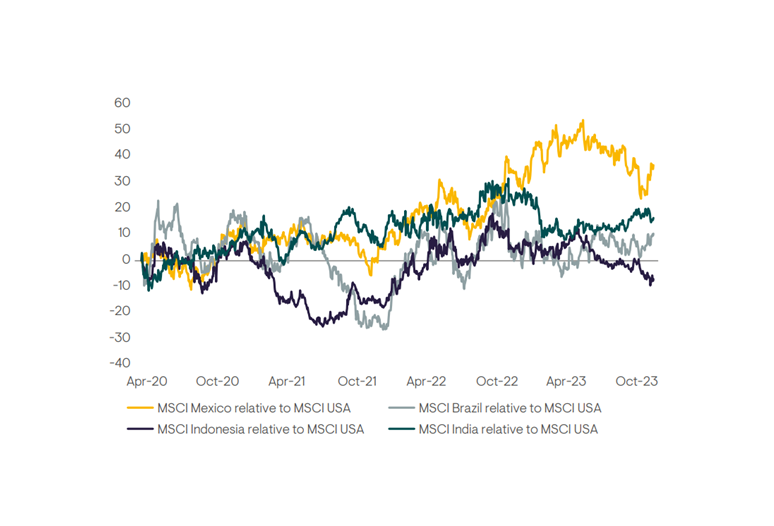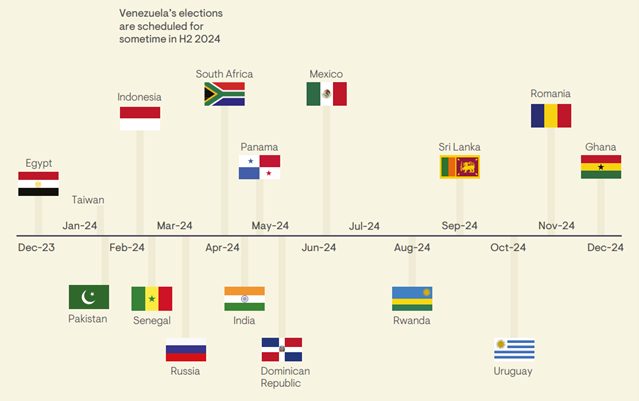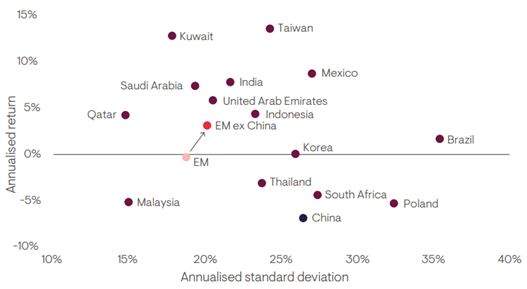The emerging market slumber is over - and 7 stocks to participate in the awakening
Emerging market (EM) equities have been in a more-than-decade-long bear market relative to developed market stocks, notes Varun Laijawalla, Co-Portfolio Manager at Ninety One. And whilst he’s quick to caveat the following commentary with a warning about the difficulty of timing inflection points, he believes “the building blocks for a turnaround are falling into place".
Laijawalla goes on to add that the EM country group is extremely heterogeneous. “We would justify writing an EM equity outlook because global investors often think about it as a single allocation within their portfolios."
But recent returns have varied widely, and so do the outlooks. As the chart below shows, some EM stock markets have quietly outperformed amid the top-down equity narrative of US hegemony of recent years.
"As ever, we think selectivity and active portfolio management will be key in the year ahead”.

Source: Ninety One, Bloomberg, as at 31 October 2023
In the following Rapid Fire, Laijawalla dives deeper into the opportunity in emerging market equities, focusing on key geographies, the China story, and the impact of 4 billion global citizens voting this year – many of them in emerging market countries.
EM equities have been serial underperformers for a long time (when compared to developed market stocks). If and when will this change and what will be the catalyst?
- First, some emerging markets, like Mexico, Vietnam and India, are already starting to win big in the new multi-polar world economy.
- Second, if, as expected, the US economy continues to weaken, upward pressure on the US dollar will likely end – which, as we noted, has been a longstanding headwind for emerging markets. EM equities tend to outperform sharply in periods of US dollar weakness because of the beneficial impacts on credit and trade in emerging markets.
- Third, with policy ‘normalising’ in developed markets and policy easing in emerging markets, the 15-year advantage of rock-bottom interest rates enjoyed by developed market companies will fade.
- Finally, EM equities are an early-cycle asset class and tend to perform strongly as the world recovers from a recession.
After a long famine, the feast may be beckoning.
Those entering EM equities now would need to do so with full awareness that the next 12 months could be rocky. But with sentiment towards the asset class subdued at best, there are plenty of good EM companies with long-term potential whose shares look inexpensive to us. Or, as one of our equity portfolio managers put it in our Investment Views, “You’re buying an asset class which is on its knees in terms of valuation, and where companies’ returns on equity and margins are heading north. So you’re getting more for less, effectively… if you can stomach it.”
By region, we think Latin American equities should continue to be buoyed by falling interest rates. We also see opportunity in China. We may be close to peak negativity in China, politically, economically and towards companies. A Chinese cyclical recovery is not priced into Chinese equities and we think China’s authorities have the potential to deliver one. Among the areas of the large and diverse Chinese equity market (there are c.4,000 listed Chinese companies), we would highlight the energy transition; the shift to consumer premiumisation; and travel, with flights from the US to China still one-tenth of the number pre-pandemic.
More broadly, geopolitical tensions, in tandem with shifting domestic politics, are changing the EM equity opportunity set. For example, with some companies looking to reduce the exposure of their supply chains to US-China relations, there are industries in India today that barely existed five years ago – such as the manufacture of Apple (NASDAQ: AAPL) products. The challenges of investing in India include valuations, governance and geopolitics. However, on-the-ground research has produced some interesting candidates for our portfolios. Meanwhile, Mexico has never done more business with the US.
Finally, South Korea has been the poster child for equity cheapness for a long time. A lot of the ‘Korean discount’ to global equities – partly a function of corporate governance standards and historical approaches to capital allocation by Korean management teams – is justified. But Korean equities could be a wildcard pick on a medium-term horizon as the country is up for potential elevation from an emerging market to a developed market status.
By industry, some large technology companies in emerging markets (falling not only within the IT sector but within consumer discretionary and communication services too) have interesting return potential. Separately, parts of the industrial sector stand to benefit from a strong investment cycle in the Middle East, as well as investment in the resilience of supply chains and the energy transition.
What’s the outlook for 2024 and what are you basing your thesis on?
In 2023, the great majority of global stock market performance was driven by only one theme – artificial intelligence – manifested in an extraordinarily narrow number of companies. Given this backdrop, this has not been a great time to be a stock picker.
Looking forward into 2024, however, much of this macro-volatility is potentially in the rear-view mirror. We can see the potential for returns to be driven much more by the companies that have been most resilient or have adapted best to this turbulence. However, there are also likely to be many companies that have yet to wake up to the changes the volatile macro situation has wrought in their businesses.
In other words, we are hopeful this will be a year where the market focuses on winning and losing companies, creating a much friendlier environment for stock pickers such as ourselves.
Emerging markets are a disparate range of countries, at different points in their economic cycles and with widely differing policy environments. This makes for an exciting stock-picking opportunity looking forward in our view. In particular, with economic growth likely to be slow and/or slowing in 2024, we believe markets are likely to reward companies that can ’win’ in this environment and punish ’losers’ ferociously.
We look at a world that we believe is rich in opportunity for our investment process, where the emerging market opportunity has not been so out of favour for 20+ years. This could be a rich period for both market alpha and beta in the emerging world.
Where are you currently hunting for opportunities?
China: Depressed market sentiment and valuations mean an opportunity to buy attractive companies at even more attractive prices; neutral exposure to China taking into account China + HK + Naspers
- As China’s growth model continues to rebalance from investment to consumption, we see opportunities in consumer premiumisation, travel and energy transition.
- We are essentially neutral in terms of our internet exposures, being selective within e-commerce and maintaining our gaming exposure despite market jitters driven by the consultation at the end of December, where currently it hasn’t resulted in any change in our fundamental views
India: Heady headline valuation and key man risk remain top of mind, but as stock pickers, we continue to be excited by the idiosyncratic opportunities in the market, reinforced by our 5th research trip last November to the region in the last 18-24 months
- Large liquid and diverse equity market, with structural growth tailwinds driven by the Aadhaar identification system, financial inclusion, regulated property sector, streamlining GST, privatisation of the banking sector, etc
- Zomato (NSE: ZOMATO) and Max Healthcare (NSE: MAXHEALTH), in addition to the contributors above, are examples of investment ideas that have paid dividends
LATAM: We have nearly 13% of the portfolio in Latin America, our highest weighting in four years, reflecting our positive views on the region, given the aggressive tightening pursued by the central banks in the last 18 months+ and now the unwind of that policy
- Brazil is a cyclical story around falling interest rates reinvigorating the economy, reviving market valuations and stimulating local investor interest
- Mexico has both cyclical and secular supports at play, benefitting from near-shoring driving supply chain relocation, with more appeal than China in a new world order in certain industries, such as electronics suppliers and global auto manufacturers, and industrial utilization nearing full capacity
Rate-related opportunities:
- Real estate: Leveraged to falling rates, we are invested in property companies in LATAM, the Middle East and India (but not China). Portfolio weight in the sector is the highest it’s been in 10 years. Holdings, including Aldar (AD: ALDAR) and Emaar (AD: EMAAR) in UAE, were key contributors to performance in 2023
- Consumer staples: quality holdings that act as inflation hedge and can pass on higher costs to consumers, ie Ambev (BVMF: ABEV3), Wal-mart de Mexico (BMV: WALMEX), and Jeronimo Martins (ELI: JMT)
Style exposure: in line with our investment philosophy and style agnostic approach, our style exposures are balanced across value, growth and quality with a tilt towards momentum. The marginally positive exposure to quality at the moment is a reflection of our consumer positions and the overall resiliency of the balance sheets in the portfolio given the current environment.
Much of the world’s population is voting this year, with many EM countries going to the polls. How does this factor into your thinking and risk appetite?
Bloomberg calculates that some 40% of the world – whether measured by population or GDP – will head to the polls in 2024. Of the 40 scheduled national elections, 17 will be in emerging markets.
EM countries and regions heading to the polls in 2024 (general, presidential and local elections).

Source: Ninety One, Bloomberg, Citigroup.
The political and economic landscape surrounding elections can present both opportunities and challenges for investors, necessitating a nuanced approach to risk assessment and portfolio management. Careful management of risk will also be essential in 2024. 2024 may bring surprises should not be surprising given the lessons of this decade so far.
What will it take for China beta to improve?
Indices impacted by Chinese equity inclusion went through several rebalancing in recent history, with companies coming into the EM index at peak or high valuations. These companies subsequently saw their earnings growth and multiples derate meaningfully. However, at depressed valuations of Chinese equities today, that is unlikely to repeat. The market sentiment and depressed valuations mean the opportunity to buy attractive companies at even more attractive prices; with neutral exposure to China taking into account China, Hong Kong and Naspers.
After a year of recurrent anxiety about China, stabilisation of the Chinese economy – of which we think there is a fair chance in the next 12 months – would also spur developing economies. Policy tightening to address the imbalances of China’s growth model of the last three decades has had a materially negative impact in the past year, and China is not out of the woods yet.
The bigger picture is that the country remains in a multi-year transition to a more domestically driven, higher value-added economy. Its leadership is extremely incentivised to ensure this transition proceeds, which requires adequate nominal growth.
We think they are capable of delivering such an outcome and that Chinese domestic consumption growth should level out in 2024. As China’s growth model continues to rebalance from investment to consumption, we see opportunities in consumer premiumisation, travel and energy transition.
Does EM ex-China offer better risk-adjusted returns going forward?
Fundamentals for EM ex-China are attractive, and unsurprisingly very similar to that of the EM asset class.
Comparing asset class fundamentals

Source: FactSet, MSCI, Goldman Sachs Global Investment Research, 30 September 2023. For further information on indices, please see the Important information section.
EM ex-China has similar risk-return characteristics to EM

CTA
1 topic
1 stock mentioned

